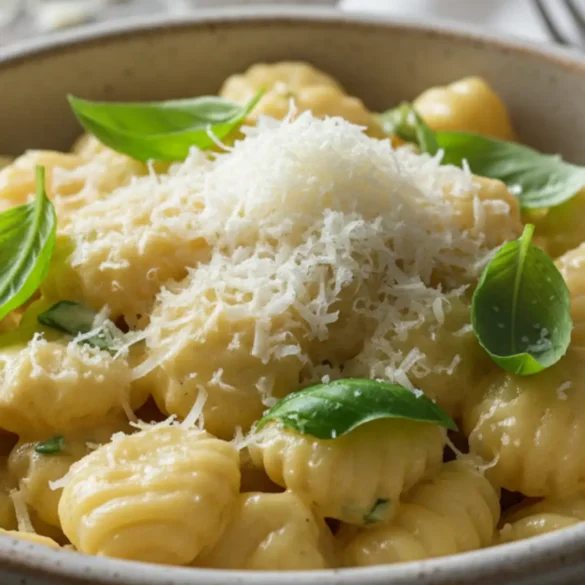Few dishes capture the essence of Italian summer like a simple, elegant pasta. Among them, the zucchette pasta recipe stands out as a true testament to the beauty of fresh, seasonal ingredients. This dish transforms humble zucchini into a luscious, creamy sauce that clings to every strand of pasta. It’s a perfect weeknight meal that is both healthy and incredibly satisfying, proving that the most memorable flavors often come from the simplest preparations.
While some pasta dishes can be heavy, this particular zucchette pasta recipe is light and vibrant. It’s an ideal way to celebrate the abundant zucchini harvest. We’ll show you how to create a rich, silky sauce without using any cream, instead relying on a clever Italian technique that coaxes incredible flavor from the vegetables themselves. This article will guide you through every step, ensuring your pasta turns out perfectly every time.
Why You’ll Love This Zuccette Pasta Recipe
This pasta dish is a perfect example of cucina povera, or “peasant cooking,” where resourceful chefs turn simple, inexpensive ingredients into something extraordinary. This zucchette pasta is not just another vegetarian option; it’s a full-flavored, satisfying meal that the entire family will love. Its subtle sweetness and savory notes make it a unique and delightful addition to your dinner rotation.
The simplicity of this dish also makes it incredibly versatile. It pairs beautifully with a crisp white wine, and you can easily add protein like grilled chicken or shrimp if you wish. The magic, however, lies in its pure, unadulterated flavor profile, which highlights the natural taste of fresh zucchini.
What is Zucchette Pasta?
The name “zucchette” literally means “small zucchini” in Italian. This dish is a celebration of the younger, more tender summer squash, though it works wonderfully with standard zucchini as well. The key is to transform the zucchini into a rich sauce, either by sautéing until very soft or by using a process that creates a velvety emulsion. It’s a classic Italian method that relies on a bit of pasta water, a generous amount of olive oil, and patience.
This recipe showcases how to create a pasta sauce that is naturally creamy without any dairy. The starch from the pasta water helps to bind the ingredients together, creating a luxurious texture. It’s a technique used by Italian grandmothers for generations and is a foundational skill for any home cook looking to master authentic Italian cuisine.
Ingredients for This Irresistible Dish

To make this simple yet elegant pasta, you will need a few high-quality ingredients. The key is to use fresh vegetables and a good-quality pasta since they are the stars of the show.
- 1 lb (450g) of short pasta such as penne or fusilli
- 3 medium zucchini, about 1.5 lbs (700g)
- 3-4 cloves of garlic, thinly sliced
- 1/4 cup extra-virgin olive oil
- 1/2 cup grated Parmigiano-Reggiano cheese, plus more for serving
- A pinch of red pepper flakes (optional)
- Fresh basil leaves, for garnish
- Salt and freshly ground black pepper to taste
Zucchette Pasta Recipe Time Table
| Component | Time |
|---|---|
| Preparation | 10 minutes |
| Cooking | 20 minutes |
| Total | 30 minutes |
Step-by-Step Instructions
Follow these simple steps to prepare this delicious and authentic pasta. The process is straightforward, but each stage is important for building flavor.
- Prepare the zucchini. Grate the zucchini using the large holes of a box grater. Squeeze out any excess moisture with a clean kitchen towel.
- Heat the olive oil in a large skillet or pan over medium-low heat. Add the sliced garlic and red pepper flakes (if using), and cook until the garlic is fragrant, about 1-2 minutes. Be careful not to let it brown.
- Add the grated zucchini to the skillet. Cook, stirring occasionally, for 10-15 minutes, or until the zucchini has softened and released its water. It should become very tender.
- Cook the pasta according to the package directions in a large pot of salted boiling water. Just before draining, reserve about 1 cup of the starchy pasta water.
- Drain the pasta and add it directly to the skillet with the zucchini sauce.
- Add half of the reserved pasta water to the skillet. Stir vigorously to combine the pasta and sauce. The starch from the pasta water will help create a creamy sauce.
- Stir in the grated Parmigiano-Reggiano cheese. Continue stirring and adding more pasta water, a tablespoon at a time, until the sauce reaches your desired consistency.
- Season generously with salt and black pepper to taste.
- Garnish with fresh basil leaves and a final sprinkling of Parmigiano-Reggiano before serving immediately.
Tips & Tricks for Perfect Zucchette Pasta

Achieving the perfect texture and flavor in this dish is all about technique. These tips will help you create a truly memorable meal.
- Squeeze the Zucchini: This is the most crucial step. Grated zucchini holds a lot of water, which can make your sauce watery and bland. Squeezing out the moisture concentrates the flavor and helps the zucchini brown slightly.
- Don’t Overcook the Zucchini: While you want the zucchini to be very tender, it should not turn into mush. Sauté it until it’s soft and slightly golden, which will develop a deeper, sweeter flavor.
- Use High-Quality Olive Oil: Since olive oil is one of the main components of the sauce, using a good quality extra-virgin olive oil will make a significant difference in the final taste.
- Reserve Plenty of Pasta Water: Pasta water is the secret ingredient for creating a smooth, emulsified sauce. The starch in the water helps the sauce cling to the pasta, giving it that classic creamy texture without any dairy.
The Secret to a Creamy Zucchini Sauce

The hallmark of a great zucchette pasta recipe is the sauce. It should be light yet incredibly rich, enveloping each piece of pasta. This creamy texture is achieved through a technique known as emulsification, where oil, water, and starch are brought together to create a cohesive and smooth sauce. The grating of the zucchini is a key part of this process. It breaks down the vegetable’s structure, allowing it to release its flavors and soften more quickly. This method ensures you get a silky, homogeneous sauce rather than chunks of zucchini in your pasta.
The final emulsification happens in the pan when you toss the cooked pasta with the zucchini, cheese, and a splash of reserved pasta water. The heat, combined with the continuous stirring, marries all the ingredients into a single, cohesive sauce. This creates an unforgettable creamy texture without the need for cream, butter, or other dairy products.
The Importance of Grating
Grated zucchini cooks much faster than sliced or diced zucchini. This is important for developing the sauce’s flavor without overcooking the vegetable. The smaller pieces also break down more easily, contributing to the smooth texture of the final sauce. A box grater works perfectly for this task.
Don’t Overcook
The goal is to cook the zucchini until it’s very tender but not disintegrated. Overcooking can lead to a watery, mushy sauce. You’ll know the zucchini is ready when it has taken on a slightly translucent appearance and has a golden color from the olive oil.
Conclusion
This simple yet elegant zucchette pasta recipe is a perfect example of how a few humble ingredients can create a dish that is truly extraordinary. It’s a light, creamy, and flavorful meal that is ideal for a quick weeknight dinner or a special lunch. The natural sweetness of the zucchini, combined with the savory notes of garlic and cheese, creates a balanced flavor that will delight your senses. I hope you enjoy making this delicious dish as much as I do. Give this a try tonight and let me know in the comments below how it turned out for you!
Frequently Asked Questions (FAQ)
What kind of pasta works best for this recipe?
Short pasta shapes like penne, fusilli, or orecchiette are ideal because their ridges and scoops are excellent at holding onto the creamy zucchini sauce. Long pasta like spaghetti or linguine will also work well.
Can I make this recipe vegan?
Yes, absolutely. To make this a vegan zucchette pasta recipe, simply omit the Parmigiano-Reggiano cheese. You can substitute it with a plant-based parmesan alternative or add a tablespoon of nutritional yeast for a cheesy, savory flavor.
How should I store leftovers?
Store any leftover pasta in an airtight container in the refrigerator for up to 2-3 days. The sauce may thicken slightly, so you can reheat it with a splash of water or vegetable broth to loosen it up.

Ingredients
- 1 lb (450g) of short pasta such as penne or fusilli
- 3 medium zucchini, about 1.5 lbs (700g)
- 3-4 cloves of garlic, thinly sliced
- 1/4 cup extra-virgin olive oil
- 1/2 cup grated Parmigiano-Reggiano cheese, plus more for serving
- A pinch of red pepper flakes (optional)
- Fresh basil leaves, for garnish
- Salt and freshly ground black pepper to taste
Instructions
- Prepare the zucchini. Grate the zucchini using the large holes of a box grater. Squeeze out any excess moisture with a clean kitchen towel.
- Heat the olive oil in a large skillet or pan over medium-low heat. Add the sliced garlic and red pepper flakes (if using), and cook until the garlic is fragrant, about 1-2 minutes. Be careful not to let it brown.
- Add the grated zucchini to the skillet. Cook, stirring occasionally, for 10-15 minutes, or until the zucchini has softened and released its water. It should become very tender.
- Cook the pasta according to the package directions in a large pot of salted boiling water. Just before draining, reserve about 1 cup of the starchy pasta water.
- Drain the pasta and add it directly to the skillet with the zucchini sauce.
- Add half of the reserved pasta water to the skillet. Stir vigorously to combine the pasta and sauce. The starch from the pasta water will help create a creamy sauce.
- Stir in the grated Parmigiano-Reggiano cheese. Continue stirring and adding more pasta water, a tablespoon at a time, until the sauce reaches your desired consistency.
- Season generously with salt and black pepper to taste.
- Garnish with fresh basil leaves and a final sprinkling of Parmigiano-Reggiano before serving immediately.
Notes
- Squeeze the Zucchini: This is the most crucial step. Grated zucchini holds a lot of water, which can make your sauce watery and bland. Squeezing out the moisture concentrates the flavor and helps the zucchini brown slightly.
- Don't Overcook the Zucchini: While you want the zucchini to be very tender, it should not turn into mush. Sauté it until it’s soft and slightly golden, which will develop a deeper, sweeter flavor.
- Use High-Quality Olive Oil: Since olive oil is one of the main components of the sauce, using a good quality extra-virgin olive oil will make a significant difference in the final taste.
- Reserve Plenty of Pasta Water: Pasta water is the secret ingredient for creating a smooth, emulsified sauce. The starch in the water helps the sauce cling to the pasta, giving it that classic creamy texture without any dairy.
